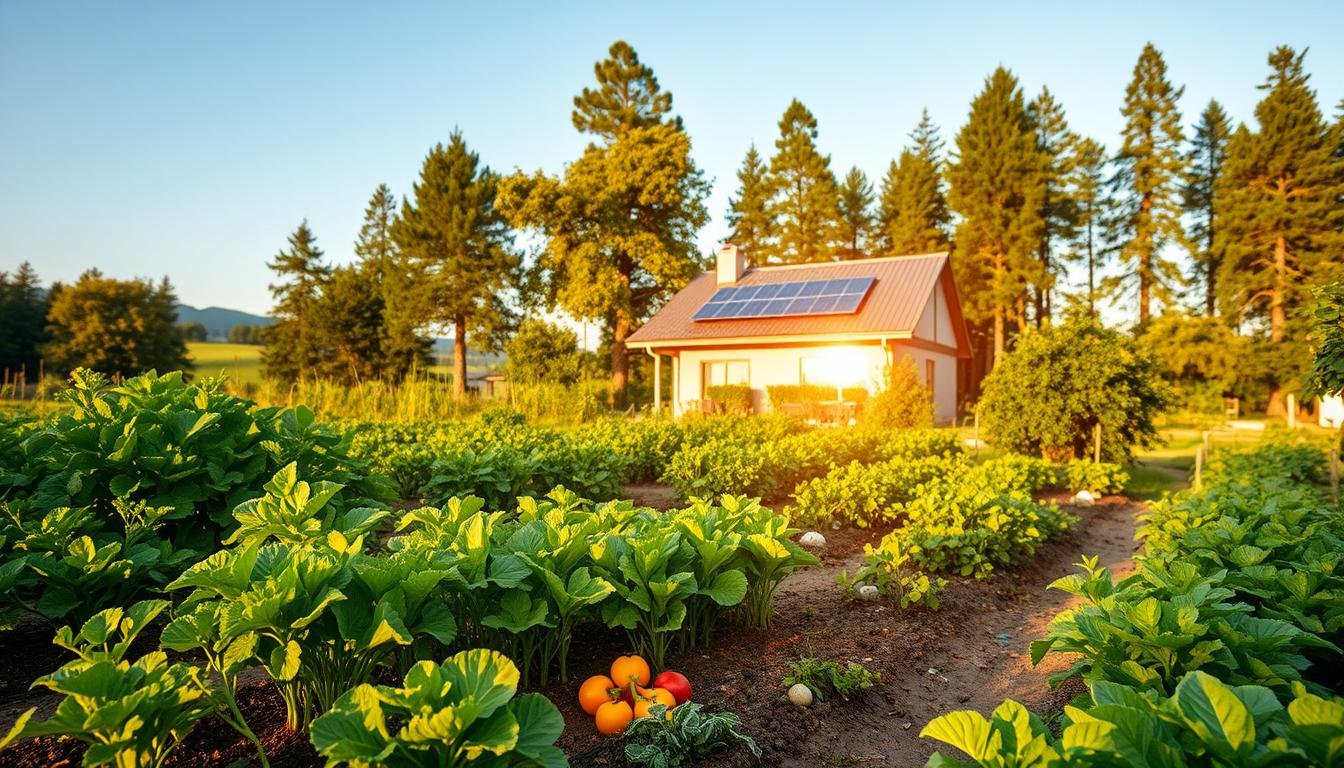Living sustainably is crucial today. We’re all searching for ways to cut down on waste and save energy. This guide provides practical tips to help you live greener.
By picking eco-friendly choices, we can all support the planet. Let’s find out how to make a difference together. Discover the possibilities of sustainable living with us.
What is sustainable living?
Sustainable living means we try not to harm the environment. It’s about using less and saving resources for the future. For example, using less energy and choosing organic food helps a lot.
By doing these things, we can all help make the world a better place.
Importance of eco-friendly alternatives
Eco-friendly choices are key for a better future. They help protect our planet and keep resources safe. Choosing products that are good for the environment is very important.
For instance, using biodegradable cleaners and reusable bags helps a lot. These small changes can make a big difference for our planet.
Reducing Energy Consumption
Switching to renewable energy sources
Using renewable energy is a big step towards a greener world. Solar and wind power are great examples. They help us use less fossil fuels and reduce pollution.
Things like solar panels and wind turbines are good for our planet. They show us how to live in a more sustainable way.
Energy-efficient appliances and practices
Choosing energy-efficient items is smart. They use less power and can save money. For example, LED bulbs use much less energy than old bulbs.
Buying appliances with the Energy Star label is also a good idea. It means they use less energy. This helps our planet and saves resources.
The benefits of energy conservation
Conserving energy has many benefits. It can save you money on bills. It also helps the environment by using less fossil fuels.
Using less energy also encourages new technologies. This leads to a more sustainable future for all of us.
Conserving Water Resources
Water-saving fixtures and appliances
Water-saving items are crucial for a greener lifestyle. They help us use less water without losing quality. Low-flow showerheads and faucets are great examples.
Using these items helps save water and reduces waste. It’s a simple way to make a big difference for our planet.
Rainwater harvesting
Rainwater harvesting is a green way to collect and store rainwater. It collects rainwater from roofs and stores it for use. This method saves water and helps us use it wisely later.
Using rainwater for things like watering plants and washing clothes helps us use less water. It’s a simple way to live more sustainably. Rainwater harvesting helps us save water and live greener.
Reducing water waste
Reducing water waste is key to being eco-friendly. Simple changes like using low-flow faucets save a lot of water. Fixing leaks quickly also helps a lot.
Using water-saving features in appliances like washing machines saves water and money. These changes are good for the planet and your wallet.
Sustainable Transportation
Public transportation and carpooling
Using public transport and carpooling cuts down on carbon emissions. They help the environment and save money. Carpooling means fewer cars on the road, which is better for everyone.
These options also save money on car costs. They’re good for the planet and your wallet.
Cycling and walking as alternatives
Cycling and walking are great for the environment and your health. They reduce pollution and help you stay fit. Choosing to walk or bike instead of drive is good for you and the planet.
These activities make you healthier and help the environment. They encourage us to live greener and healthier lives.
Electric vehicles and hybrid cars
Electric and hybrid cars are better for the planet. They use less fuel and produce fewer emissions. This makes the air cleaner and healthier.
They also use energy when you brake, making them more efficient. Electric and hybrid cars are leading us to a greener future.
Eco-friendly Alternatives in Everyday Life
Green cleaning products
Green cleaning products are better for our homes. They use natural ingredients instead of harsh chemicals. Natural cleaners and biodegradable detergents are safer for our homes and the environment.
Using eco-friendly cleaning sprays with essential oils is also good. These products make our homes healthier and cleaner.
Reusable and biodegradable materials
Choosing reusable and biodegradable items helps the environment. They reduce waste and protect our planet. Reusable bags and biodegradable packaging are great examples.
These choices help us live more sustainably. They reduce our carbon footprint and support a healthier planet.
Reducing single-use plastics
Reducing single-use plastics is key to a greener future. Using reusable items like stainless steel water bottles or cloth bags cuts down on plastic waste. These small steps can make a big difference. The average person uses hundreds of plastic water bottles and countless plastic bags yearly.
Choosing products in recyclable materials like glass or paper also helps. Making choices to avoid single-use plastics helps our planet stay clean and green.
Sustainable Food Choices
Organic and locally sourced foods
Choosing organic and locally sourced foods is good for the planet. It supports local farmers and lowers your carbon footprint. Buying organic fruits and veggies from farmers’ markets cuts down on emissions.
Organic farms also improve soil health and biodiversity. They avoid harmful pesticides and GMOs. So, eating organic and local is good for you and the planet.
Plant-based diets
Plant-based diets are better for the environment. They reduce your carbon footprint by eating less animal products. For example, tofu, lentils, or tempeh can save water and cut emissions from farming.
Plant-based meals also help preserve biodiversity and reduce deforestation. Making this change helps the environment.
Reducing food waste
Reducing food waste is essential for a greener lifestyle. Minimizing waste can greatly reduce our environmental impact. Using leftovers creatively is a good start. It saves money and reduces waste.
Proper storage, like using airtight containers, also helps. These simple steps can make a big difference in reducing waste and living sustainably.
Promoting Sustainable Fashion
Eco-friendly fabrics and materials
Eco-friendly fabrics and materials are better for the planet. They cause less harm from production to disposal. Organic cotton, for example, avoids harmful pesticides and fertilizers. Recycled polyester uses less energy than new polyester.
Tencel, made from wood pulp, is water-efficient and biodegradable. Choosing these fabrics helps preserve our planet’s resources.
Slow fashion and secondhand shopping
Slow fashion and secondhand shopping are sustainable choices. They reduce environmental impact by choosing durable, timeless pieces. Secondhand shopping gives old clothes a new life, reducing waste.
These choices are good for the planet and let you express your style. Shopping consciously is fulfilling and impactful for those wanting to change the fashion industry.
Ethical fashion brands
Ethical fashion brands focus on eco-friendly options. They use sustainable materials and methods to reduce environmental harm. For example, they might choose organic cotton or recycled fabrics.
These brands also care about fair working conditions. They ensure workers get fair pay and work in safe environments. This sets a good example for the fashion world, encouraging others to follow.
Summary
This article helps you live more sustainably. It talks about many areas like home, transport, food, and fashion. It shows how to make choices that are better for the planet.
Even small changes can have a big impact. They help us work towards a greener future. By working together, we can make the world more sustainable.







